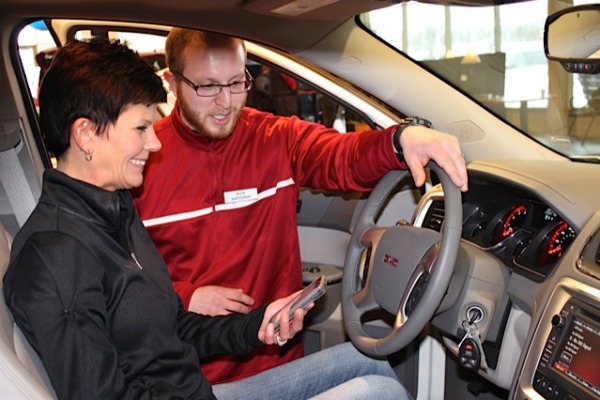
When you're shopping for a car, the experience you have at a dealership can make all the difference. Edmunds.com Senior Editor Matt Jones worked for 12 years as car salesman, dealership Internet sales manager and finance and insurance manager. He now writes stories that highlight dealerships and car-selling best practices that make car-shopping easy and enjoyable. Got an innovative dealership story to share? Contact him: matthewj (at) edmunds.com
To entice car shoppers, automakers have been adding more and more cutting-edge technologies to new vehicles. Products like Bluetooth, back-up cameras and voice-controlled navigation systems will be found in almost every new car sold this year.
These features can certainly make a car more convenient, entertaining and safer. But learning how to use these additions can be a daunting task. The average American only buys a new car once every six years. Car technology can change a lot in that time.
A 2014 Honda Odyssey, a popular minivan, for example, can have as many as three information screens, a built-in hard drive, a split-screen DVD player and three zones of air-conditioning. And then there's that onboard vacuum cleaner.
To ensure that buyers get a good introduction to their new cars, some forward-thinking dealerships are creating what they call vehicle delivery teams. ("Delivery" is a dealership term for the completion of the purchase process. It doesn't literally mean the delivery of a car to a buyer's home or office, though some dealerships provide that service.)
Vehicle delivery teams are made up of people who not only understand technology but can explain how to use it. Often, delivery team members have little or no previous car sales experience. It's not uncommon for dealerships to recruit people who have worked in places like electronics stores. It makes sense: If someone can explain how a wide-screen TV interfaces with a wireless speaker setup, there's a good chance she can explain Bluetooth to a car buyer.
It appears that the teams are doing a good job. Customer satisfaction scores jumped after D'Arcy Buick GMC in Joliet, Illinois, introduced delivery teams to its store, says Keith Searls, D'Arcy's sales manager.
"This addition has been good all around," he says. "Our customers get in-depth instruction on navigation, Bluetooth and all the other tech today's cars have. The explanations are seamless, and we now have additional go-to guys to answer tech questions."
Carmakers are jumping on the better-delivery bandwagon, too. Both BMW and Mercedes now have manufacturer-driven programs to ensure that dealerships are teaching buyers how to use the features of the brands' new cars.
In 2012, Mercedes launched its Mercedes-Benz Delivery app, which guides salespeople through a delivery process that educates the new buyer how to use the brand's more advanced features and technology. Mercedes also has online how-to videos that help give buyers refreshers on how to use the new tech.
BMW's program, Encore, takes a slightly different approach: Knowing that buyers are flooded with information at purchase time, BMW is inviting new car buyers back to the dealership for a refresher course on how to use a car's bells and whistles. This "encore" visit usually takes place 60-90 days after the car's purchase.
The move to better car delivery is in part a response to the fact that automakers' quality scores have suffered in recent years as buyers have fumed over the difficulty of using in-car technology. A notable example was Ford's Sync, which sunk the automaker's J.D. Power Initial Quality survey score in 2011. Education is seen as an antidote to the dangerous perception that a carmaker's tech is so complicated that it borders on being defective.
Here is how vehicle delivery teams typically work: After buyers sign the last document, the salesperson introduces them to the delivery specialist, who takes the new car owner on a quick tour of the dealership, paying special attention to the service department. After the tour, the delivery team member goes over the instruction books and service manuals for the new car.
When the car is prepped and ready for the buyer, the buyer and delivery specialist inspect it for dents, dings and scratches. They then go into the vehicle tutorial, which can last from 20 minutes to an hour.
During this time, the delivery specialists will walk the owner through all basics: seat adjustments, power-window operations and how to move the rear seats. They'll typically pair the owner's phone, explain steering-wheel controls and go over other safety or convenience features.
Having a dedicated delivery specialist also creates some not-so-obvious benefits for both the customer and the dealership. A better-than-average salesperson may deliver 15 or so new vehicles a month, whereas a delivery specialist, who works with many salespeople, may do that in a weekend. The experience that comes from so many deliveries translates into more thorough explanations, quicker phone pairing and better answers to commonly asked questions.
Another benefit of having a delivery team, according to Searls, is that while a new specialist is handling the car introduction, the salesperson is free to assist other customers. On a busy sales weekend, having another salesperson on the floor speeds up the shopping process for both the customer and the dealer.
Adding a delivery team to a dealership isn't going to completely transform the car-shopping landscape, nor will it turn a bad shopping experience into a good one. Those things happen when dealerships look to improve the overall sales process. But a delivery team does two things: It gives customers a great start with their new cars and shows that a dealership is serious about buyers getting the most out of the car they purchased with their hard-earned dollars.